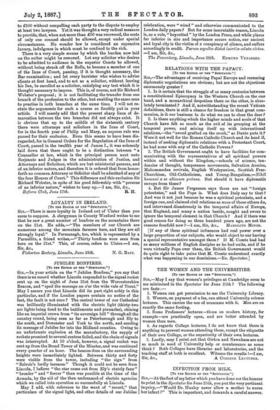LETTERS TO THE EDITOR.
BARRISTERS AND SOLICITORS.
[To TUX EDITOR OP "aescrrarea."]
Sra,—In your admirable article on " Solicitors," in the Spectator of June 11th, you allude to the necessity under which the client now labours to employ two lawyers of different kinds to bring his case before the Courts. This obligation appears the more oppressive, when it is borne in mind how small are the amounts at stake in many actions. The average amount recovered in actions tried in London during the year ending August 12th, 1885, the last year for which the judicial statistics are at present published, was between £500 and 2600 ; while at the Assizes it was about £200. The higher rate prevalent in London is no doubt due to the fact that the figures there apply to Chancery as well as to Common Law cases. The character of the work in the Common Law Courts may be gauged from the classification of actions for the recovery of money tried on circuit. There were 86 actions in which not more than £20 was recovered; 104 in which the maximum figure was £50; in 118 actions, the sum ranged from £50 to £100; and in 95, from £100 to £200; while there were only 17 cases in which more than £1,000 was recovered, and not a single case above £5,000. Thus, in more than three-fifths of the actions in which money was recovered at the Assizes, the amount did not exceed £100. It is obvious that in these cases the coats must have amounted to far more than the sum at stake, and from the time the briefs were delivered, must have constituted the real bone of contention. It approaches an absurdity that the Courts should not be able to determine a controversy relating
to £100 without compelling each party to the dispute to employ at least two lawyers. Yet it was thought a very radical measure to provide, that, when not more than £50 was recovered, the costs of only one counsel should be allowed, except under special circumstances. No wonder law is considered an expensive luxury, indulgence in which must be confined to the rich. There is a very simple means by which the burden now laid on the suitor might be removed. Let any solicitor who desires to be admitted to audience in the superior Courts be allowed, without being struck off the Rolls, to become a member of one of the Inns of Court, passing, if it is thought necessary, the Bar examination ; and let every barrister who wishes to advise clients at first hand, and to act as a solicitor, without leaving his Inn, be enrolled as a solicitor, satisfying any test which it is thought necessary to impose. This is, of course, not Sir Richard Webster's proposal ; it is not facilitating the transfer from one branch of the profession to the other, but enabling the same man to practise in both branches at the same time. I will not re- state the arguments for such a course so forcibly put in your article. I will merely add that the present sharp lines of de- marcation between the two branches did not always exist. It is obvious that up to the middle of the sixteenth century there were attorneys and solicitors in the Inns of Court, for in the fourth year of Philip and Mary, an express rule was passed for their exclusion. Even this seems to have been dis- regarded, for in General Orders for the Regulation of the Inns of Court, passed in the twelfth year of James I., it was solemnly laid down that there ought to be a distinction between " a Counsellor at law, which is the principal person next unto Serjeants and Judges in the administration of Justice, and Attorneys and Solicitors, which are but ministerial persons, and of an inferior nature, and therefore it is ordered that from hence- forth no common Attorney or Solicitor shall be admitted of any of the four Houses of Court." This difference and this exclusion Sir Richard Webster, in spite of his good fellowship with "persons of an inferior nature," wishes to keep up.—I am, Sir, &c.,



































 Previous page
Previous page